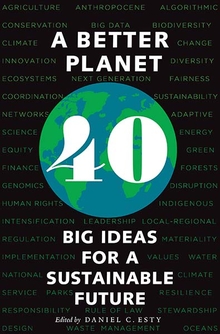A Better Planet: 40 Big Ideas for a Sustainable Future
Reviewed by Aria Ritz Finkelstein, Massachusetts Institute of Technology
How can systems thinking about democracy and inclusion, about innovation and creativity; technical solutions; and building social equity and environmental justice through community programs and initiatives promote sustainability?
A Better Planet: 40 Big Ideas for a Sustainable Future, edited by Daniel C. Esty, Yale University Press, 2019, 416 pp.
Esty gathers the thoughts of some truly brilliant and knowledgeable thinkers and scholars in the field of sustainability. The collection of proposals is too broad to even begin to do justice to in such a short review. The authors’ stances run the gamut from a belief in the power of technical innovation to an insistence on deep ecology and the intrinsic value of “nature.” Still, given the book’s title, it will not surprise the reader that the attitude throughout is upbeat. Yes, the chapters describe enormous challenges, but these writers take them on with a shared confidence that these challenges can be—will be—overcome.
The essays range across topics as disparate as Thomas Rashad Easley’s discussion of “hip-hop forestry” as joining young students with foresters and Cary Coglianese’s argument for the use of machine learning in environmental management. Some, Susan Biniaz on international agreements, for example, take on global environmental governance, while others, such as Meha Jain and Balwinder Singh on no-tillage farming, zoom into a closer frame of view.
The essays cover systems thinking, democracy and inclusion, innovation and creativity. All of these terms risk becoming buzzwords, and because of the sheer number of the essays none can dive too deeply into its subject. However, each bite-sized chapter offers enough to introduce the reader to the problem it addresses, to explain what its stakes are, to outline the broad conversation already being had around it, and, usually, to offer a path forward and even a way to join in.
The sections vary in tone and orientation, in ways not entirely surprising. For example, the “Innovation and Technology” section gathers pieces that place their optimism in technical solutions. The “Society, Equity and Process” pieces, as a group, tend to focus more on building social equity and environmental justice through community programs and initiatives. As a group they manage to concisely and engagingly lay the historical groundwork needed to grasp the issues they are tackling, explain why they are important, and suggest at least one path forward. Another thing the writers have in common: Each is almost unflaggingly optimistic.
The collection might benefit from a more structured conversation between the pieces, one that would bring the ideologies and assumptions behind them, and the implicit conflicts between them, into sharper relief. The book shies from facing the full complexity and difficulty of challenges—especially intensely political ones—head on. On the other hand, the way the essays stand alone demonstrates faith in the reader’s capacity to grasp without handholding.
The book is a conversation-starter. This moniker is often a pejorative one, but here it is the book’s strength. On this point, Esty is explicit: “Indeed, our goal is not just to contribute to the substance of the policy dialogue over our environmental future but also to demonstrate how to have such a conversation. So please join us in this debate.” And, at the end of the collection, he invites the reader to participate in an online conversation, an exchange into which the book is only one entrance. The book is welcoming. Together, its essays add up to an entryway into those discussions that have the potential to shape the world to come.

